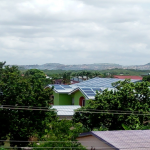SOME FOODS YOU CAN’T MISS IN GHANA

On a cool morning in Ghana…the smell of fresh bread and something frying in hot oil can’t be avoided at all. You see people with cups in their polyethane bags…some kids sent from home carry food flask of various shapes and colours. If you are new in town don’t worry…you will just have to get a little closer to see what’s actually happening. It’s common to see people in a queue for it. Apart from being nutritious, it saves you the time of preparing breakfast. Usually served by the women from the North and now being adopted by the Southern women, the kind of breakfast is patronized by 80% of school children and over 50% of workers. For labourers and market women, it’s like an everyday communion. Am talking about “Hausa Kooko”.
Made from millet and some spices like ginger, this thick flowing delicious solution usually goes with fried Bean cake (popularly known as koose), pinkaso, buff loaf (boflot) or bread. Other do the combination of bread and koose. It’s either served in a bowl, cup, calabash or a rubber. In recent times some people have even started serving working customers in disposable cups. The combination is rich in protein, carbohydrate and other nutrients. You want to give your hausa kooko a more sweet taste?..don’t forget to add some milk or groundnut. Don’t forget that it usually goes with a sweetner.
Like I said earlier it’s not everyone who has the luxury and time of preparing breakfast every morning, that why Auntie Grace has made it possible for people to enjoy good breakfast without stress by preparing a variety of cereals. From her you can get Oats, tombrown (roasted corn porridge), oblayo(corn porridge), akweygbemi(another king of corn porridge) and rice water. These cereals go with milk or groundnut with bread. With 2Gh cedis you ca get full. But when you have a bigger tummy for breakfast you can suit yo0urself with something above 2 cedis.
Another food that’s popular in the mornings is waakye. Waakye by simple description is rice and beans. With the Ghanaian kind of waakye. The rice and beans is usually boiled with some leaves known as waakye leaves. This gives the food a peculiar colour. Waakye normally goes with gari, meat, egg, wele, fried plantain and shito or stew. You don’t neccesarily need to have all these on your plate though.
There are some joints that require you joining very long queues to get served. In recent times, a lot of these waakye seller have delivery services, you just have to get your order straight and give them a call. Depending on where you are, you get your food and you are good to go. The delivery usually comes at a cost.
These are pictures of how waakye looks like. Mostly when it is served in these leaves it gives it some native flavor. You can decide to eat it in a plate or away container.
For the heavy breakfast eaters who want something that can sustain them to late afternoon, don’t worry at all. Ghanaians always have something for everyone. Ga kenkey is the next thing to talk about. Usually made by the women of the Ga tribe, this meal is made from corn dough and wrapped in dried corn cover.
It’s called Ga Kenkey because its attributed to that tribe. Moreover there’s another type of Kenkey which is made by the fantes. So the Ga is to differentiate the two.
Ga Kenkey is served with pepper sauce, shito, fish or meat. Some people take it with pear, or egg. Most of the hard labour workers take this as brunch and wait for supper. Kenkey is believed to be more enjoyable when it is eaten in a group. Kenkey and waakye can also be taken for lunch.
Popularly known to the younger folk as “Gobe”…and to others as red red. Fried plantain with bean stew is another delicious and to me irresistible meal. For those who make it in restaurants or some chop bars, its bean stew but for most of the roadside seller, its beans, oil(red or coconut oil) and gari.
The three are mixed together to form the mixture which can be seen as stew. This stew goes with fired plantain and sometimes fried potatoes. My friends from school would say beans eaten with meat fish or egg is double protein eating but a lot of Ghanaians don’t eat their red red without fish or egg.
Some others decide to add plain rice to it and they say that it makes the meal more complete.
A good evening in Ghana, goes with either good food or something to keep your mouth busy. Looking around I would say that apart from Khebad….known also as chinchinga, fried spiced plantain is very popular. Locally refered too as kelewele, this delicacy is seen almost in every corner at night.
Kelewele when hot is very mouth watering. I would say that the aroma from it being fried would keep you waiting for it to be well cooked. Some take it with groundnut paste as some others do so with roasted groundnuts.
To make the kelewele business more attractive some people sell it with fried chicken wings or gizzard. Its served usually in a takeway container or a piece of paper. If you are not really a fan of pepper, you should get some water aside because, some can be very spicy.
At a point in time, this night delicacy was considered poisonus by a lot of people because they said it contained so much fats and oils but surprisingly , it has surfaced into the system. Am referring to Domedo…aka fried pork.
People have had their families in this businesses for years now. Fried pork is eaten with some pepper powder. A lot of people buy it as an accompaniment to other dishes whiles some just as a “chewy thing”. Though it contains fat…its better than “poky”(fried turkey) like one pork seller said.
Normally young guys throwing parties, serve pork. They say it’s the best match to go with some alcoholic drinks.
It’s amazing that in Ghana, most of the things that are usually accepted now, were formally despised. When indomie noodles came into the system, a lot of people said that it was not nutritious but rather had some chemicals which were harmsful to human health.
Now, there are indomie sellers everywhere in Ghana. It’s a mixture of vegetables, noodles, egg, pepper, spices and corned beef or sardine. The amount of pepper the cook uses is usually dependent on the buyer. You can always get it fresh and hot since its prepared upon order. A lot of kids have gotten so used to indomie noodles so much that they can barely do without it. Its eaten by adults too and a lot of people see it as a quick fix. When you get home from work, you will just have to get your pack of indomie which goes for between 5 Ghana cedis and 12 Ghana Cedis.
To make these foods safe for consumption, the Ghana Standards Authority has developed a code of hygienic practices for street vended foods, in view of the widespread consumption of street food. The code provides three principle areas; the suitable conditions under which food should be sold, the caliber of people who should sell food and the processes under which the foods are prepared. Most of the sellers need to wear hair covers and aprons, appear clean and neat with trimmed finger nails
Most of these foods are nice depending on where they are bought. Some people have secret recipes which make their food tastier than others. One thing I can assure any visitor o Ghana is that when it comes to food, Ghana is never boring and you can find something just perfect for yourself at any time of the day.











